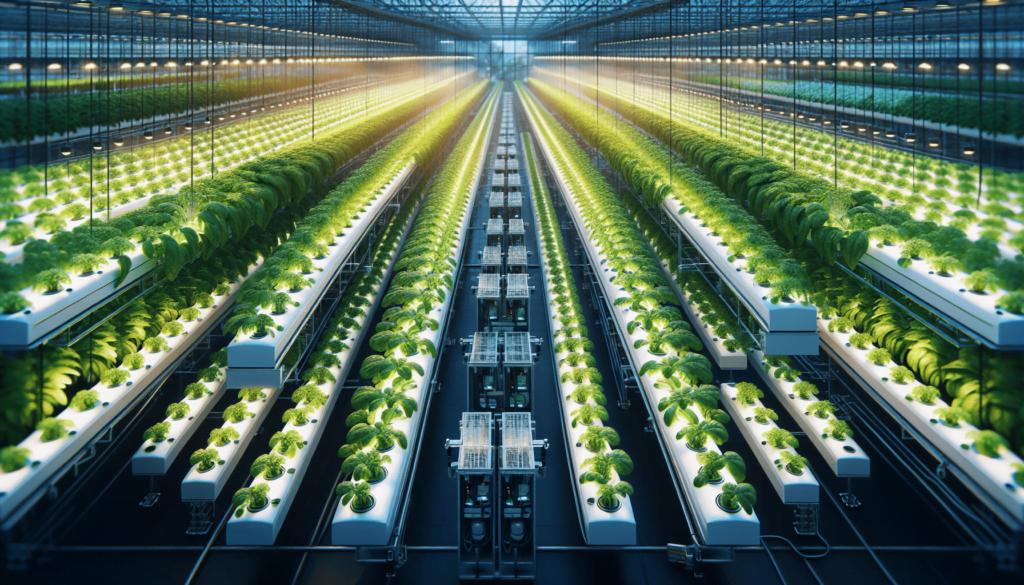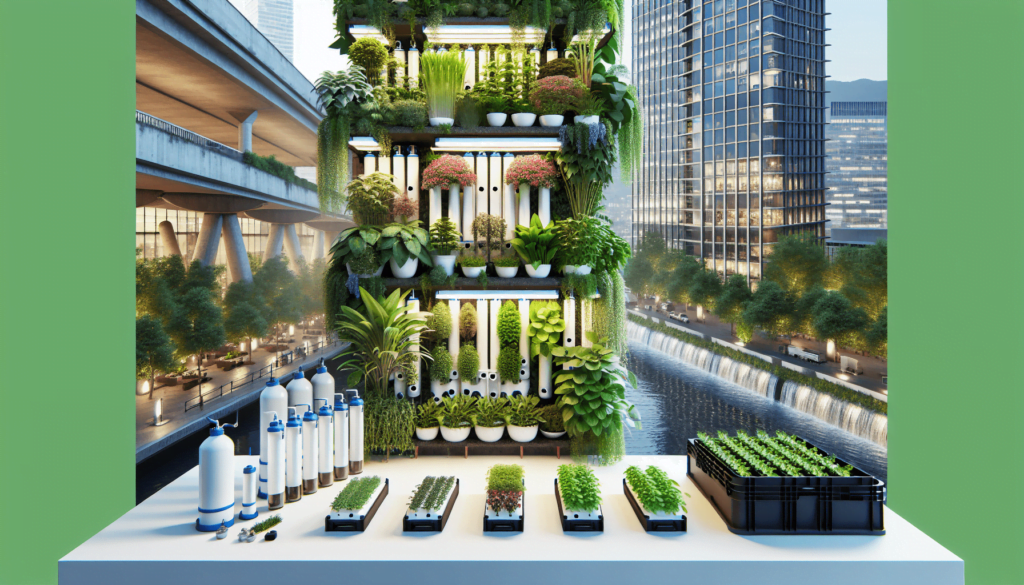Journey with us as we traverse through the budding prospects and anticipated breakthroughs in the rapidly advancing world of hydroponic farming. In what promises to shape our future in remarkable ways, this cutting-edge cultivation technique revolutionizes traditional farming, adopting a mix of science and innovation to optimize plant growth without soil. This remarkable narrative fosters a clearer understanding of how hydroponic farms could very well be the next significant stride towards a more sustainable, efficient, and resource-conserving agriculture industry.
Benefits of Hydroponic Farming
Hydroponic farming, an innovative way of growing crops without soil, offers us numerous fantastic benefits. Naturally, the discussion about hydroponics starts with enlightening its advantages.
Increased yield
One of the notable benefits we’ve observed is an increase in yield. As we can control the nutrients and environmental conditions, they get the ideal growing conditions year-round which results in faster growth and higher crop yields compared to traditional soil farming.
Space efficiency
On our hydroponic farms, we also noted the increased space efficiency. With this method, crops can be grown in stacks or in close proximity since there is no need for the plant roots to spread and search for nutrients. This permits us to grow more crops per unit area, making hydroponics an excellent choice for urban and indoor farming.
Decreased water usage
An unexpected but welcome benefit is decreased water usage. Our plants are grown in nutrient-rich water, which can be recycled and reused reducing water needs by up to 90% in comparison with traditional farming. This efficiency is highly advantageous in regions with water scarcity.
Challenges in Hydroponic Farming
While we’ve reaped the benefits, we’ve also encountered a unique set of challenges along the way.
High upfront investment
Hydroponic farming does require a high upfront investment. From setting up the systems to controlling the indoor environment such as temperature, light, and humidity, all these aspects can add up and might seem overwhelming initially.
Need for technical knowledge
Another challenge we’ve faced with hydroponic farming involves needing a good amount of technical knowledge. To regulate the plant’s environment precisely, we’ve needed to understand different growth factors, have to monitor pH levels, nutrient concentration, and balance that contributes significantly to a crops growth.
Lack of public awareness
We’ve also observed a general lack of public awareness about hydroponics. This can affect the overall acceptance and market demand for hydroponically grown crops. Efforts to educate the public about the advantages of this farming method could be beneficial.
Technological advancements in Hydroponic Farming
Advancements in technology have significantly contributed to the evolution and efficiency of our hydroponic systems.
Smart systems for control and adjustment
We’ve incorporated smart systems for control and adjustment, such as automated nutrient dosing systems, climate control systems, and artificial intelligence to analyze the crop’s needs. These advancements have made managing our hydroponics farms easier and more precise.
LED grow lights
The use of LED grow lights has revolutionized our farming practices. These lights are energy efficient and provide a full spectrum of light that can be adjusted to mimic natural sunlight, encouraging optimal plant growth.
Sustainable Hydroponic Farming Practices
In our pursuit of a sustainable future, we’ve integrated several sustainable practices into our hydroponic farming methods.
Recycling and reusing water
For us, recycling and reusing water is a prime practice in hydroponics. Not only does this practice minimize water usage, but it also ensures that we are operating our farm in a manner that benefits the environment.
Organic hydroponics
Organic hydroponics is another approach we’re using. By using organic nutrients, we cultivate produce without the use of harmful pesticides or chemicals, promoting healthy and sustainable food production.
Local farms reducing food miles
By placing our hydroponic farms near urban areas, we’ve managed to significantly reduce food miles — the distance that food travels from our farms to consumers. This helps to decrease the carbon footprint associated with food transportation.
Integration of Hydroponics with other systems
To further enhance our farming methods, we’ve successfully integrated hydroponics with other farming systems.
Aquaponics
Aquaponics — a combination of hydroponics and aquaculture – is a symbiotic system where the waste from the fish provides nutrients for the plants and in return, the plants clean the water for the fish.
Aeroponics
In contrast, our aeroponic systems allow us to grow plants in an air or mist environment without the use of soil or water-based solutions. Similar to hydroponics, it offers space and resource efficiency and allows us to grow high-density crops all year round.
Permaculture
On a larger scale, we’ve integrated hydroponics into permaculture designs. Permaculture is an approach that seeks to mimic the natural ecosystem, creating sustainable and self-sufficient production systems. Hydroponics fits well into such designs, allowing us to enhance the use of space and resources further.
Industry Trends in Hydroponic Farming
As we look ahead, we can see several trends emerging in the hydroponic farming industry.
Urban farming
Urban farming is a rapidly growing trend. By growing crops in city buildings, rooftops, and backyards using hydroponic methods, we’re not only maximizing the use of space but are also able to provide fresh, locally-grown produce to urban dwellers. This reduces food miles and ensures nutrient-rich food is available fresh year-round.
Indoor farming
Indoor farming is another upcoming trend. In an indoor environment, we can maintain the optimal climate for the crops all round the year, without being influenced by seasonal changes. This ensures a consistent supply of crops year-round.
Vertical farming
Through vertical farming, we are able to make the most of limited space, stacking crops to create ‘green towers.’ This technique enhances space utilization and yield and could become a crucial part of future farming practices in space-limited areas like cities.
Role of Research in Hydroponic Farming Future
Research has always played a pivotal role in shaping the future of our hydroponic farming practices.
Need for ongoing research
We recognize the need for ongoing research to continually improve current practices, optimize resource use, and increase the number of crops that can be grown hydroponically.
Emerging research topics
Emerging research topics such as the development of new nutrient solutions and more energy-efficient lighting systems excite us. They offer the potential to further optimize our farming practices and contribute significantly to the future of hydroponic farming.
Impact of Climate Change on Hydroponic Farming
As we grapple with climate change, we’ve come to appreciate the role of hydroponics in building resilience.
Utilizing hydroponics to combat food insecurity
We’ve found hydroponics to be a useful tool to combat food insecurity, particularly in regions affected by erratic weather patterns and extreme conditions. With hydroponic farming, we can grow food in controlled environments, irrespective of climatic conditions, ensuring a stable food supply.
Hydroponics as a tool for climate resilience
Hydroponics can be applied as a successful tool in adapting to climate change. Being able to farm without the dependence on soil quality and water availability can make our agriculture practices more resilient to changing climatic conditions, and this is a major step towards climate resilience.
The economic prospects for Hydroponic Farming
With an ever-increasing population and a rise in urbanization, we can see immense economic prospects for hydroponic farming.
Market projections
We’re already seeing a growth in demand for the market. This is expected to continue owing to the increasing global food demand, limited resources, and the need for water and land-efficient farming methods.
Investment landscape
There’s a strong investment landscape for hydroponics. With the growing interest in organic food and fresh produce, investors are recognizing the potential returns from hydroponic farms, enabling us to expand our farming operations.
Job creation potential
Hydroponic farming can also contribute to job creation, from setting up and managing hydroponic systems to processing and distributing the produce. We’ve seen this firsthand on our farms.
Education and Training in Hydroponic Farming
To further the growth and adoption of hydroponic farming, we emphasize the importance of education and training.
Importance of education
We understand that education is crucial for the successful transition to and implementation of hydroponic farming. It’s important not only for farmers but also for consumers to understand the benefits of hydroponic produce.
Available courses and training programs
Numerous courses and training programs are now available, and we strongly recommend these to aspiring hydroponic farmers. These programs help individuals understand the ins-and-outs of setting up and managing a hydroponic farm, leading to successful farming practices.
Farmers transitioning to hydroponics
We’ve seen a rising number of traditional soil farmers transitioning to hydroponics. Through the provision of training and support, we believe this transition can be made smoother, eventually leading to a beneficial and productive hydroponic farming sector.
It is clear that hydroponic farming has a promising future, packed with numerous possibilities. With its potential to revolutionize farming, make efficient use of resources, and provide solutions in the face of climate change, we believe the future of hydroponic farming is bright indeed.
Forum
Got something to share or a question to ask? Jump in and start a conversation! Whether it’s tips, advice, or just sharing your experiences, we’d love to hear from you. Don’t be shy—your input could inspire or help someone else!- This forum has 1 topic, and was last updated 10 months, 2 weeks ago by .
- Topic
- Voices
- Last Post
- You must be logged in to create new topics.



